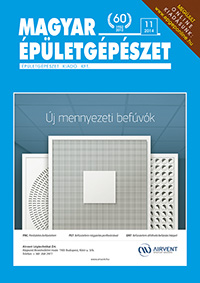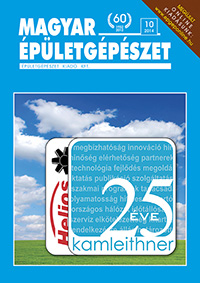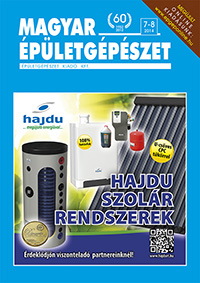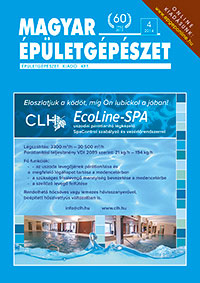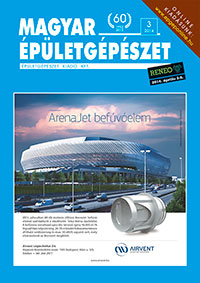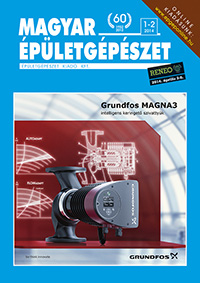Lapszámok

2014 9. szám
- Dr. Magyar Zoltán - Németh Gábor - Kampouropoulos, Konstantinos - Sala, Enric:
Termelőüzemek energia-megtakarításának meghatározása mesterséges intelligencia alkalmazásával - Monori Tamás:
A hőátbocsátási tényező helyszíni mérésének tapasztalatai Magyarországon - Koczka Péter:
Fűtési szezon – Hőkamerás felülvizsgálat - Dr. Garbai László - Kovács Zoltán:
A távfűtőhálózat hidraulikai analízisének kérdései állandósult áramlás esetén - Kubín, Milan - Hirš, Jiří:
A kis átmérőjű és műanyag bevonatú csövekben kialakuló áramlás hatása a hőátadásra - TOSHIBA AIR-COND:
Árammegtakarítás – trend vagy elkerülhetetlenül szükséges? TOSHIBA termékekkel a megfelelő úton halad! - Minier Botond:
„Smart building” – Okos megoldások Európa egyik legkorszerűbb arénájában - Knauf Insulation Kft.:
Hangszigetelés és hanggátlás korszerű anyagokkal … hogy a sportolás a pályán és a lelátón is élmény lehessen! - Dr. Szilágyi Zsombor:
Változások a földgázpiacon - Honeywell Home:
Megjelent a Honeywell új szén-monoxid vészjelző családja - Magyar Kéménygyártó Kft.:
Újdonság Társasházaknak! Gyűjtőkémény kondenzációs gázkazánok számára: KREA K2 - Tóth Attila:
VIGAS faelgázosító kazán – felkészülve a jövő kihívásaira! - Profilaxis Kft.:
A világ legjobb minőségű tágulási tartályai - TERC Kft.:
Online Költségvetés-készítő és Kiíró Programrendszer - Tóth Attila:
GALLETTI – Az ötlettől a megvalósításig – www.galletti.hu - Kovács István:
Evolúció a szellőztetés-vezérlésben - Rébay Lajos:
Tanulságos életpályák – Cservenyák Gábor
Hozzászólások
A kis átmérőjű és műanyag bevonatú csövekben kialakuló áramlás hatása a hőátadásra
Még nem érkezett hozzászólás!
Kubín, Milan - Hirš, Jiří
A kis átmérőjű és műanyag bevonatú csövekben kialakuló áramlás hatása a hőátadásra
Abstract
There are various methods that are used in technical practice to increase the heat transfer intensification. One of the possibilities is the use of pipes with plastically finished surface. The type of selected surface finish of the piping influences the flow of liquids in the piping and therefore also the heat transfer in a considerable way. The issue of the hydraulic diameter of the pipe with plastically finished surface is outlined here. The increase of transferred density of the heat flow in a pipe with plastically finished surface in comparison with a bare pipe of the same diameter is demonstrated by a practical example.
Keywords: intensity of heat transfer, pipe with plastically finished surface, hydraulic diameter, density of heat flow, flow of liquid
Introduction
In technical practice there are very often demands for heat transfer from one flowing liquid to another liquid over a fixed or movable dividing wall. In order to increase heat transfer intensification the surface of the dividing wall is finished, either on one side or on both sides. In general the heat transfer intensification can be achieved [2]:
a) By the reduction or deterioration of the boundary layer of the liquid, whose thermal resistance is crucial for determining the heat-transfer coefficient α. There are the following possibilities:
– increase of velocity of the flowing liquid w,
– introduction of variably shaped insertions on the wall
(most often helical shape), in these cases the value α
increases circa 1,5 to 5 times,
– artificially created asperity of the wall (adjustment or
deformation of the wall, porosity of the wall, indented
surface of the wall),
– pulsation of the flowing gas, when a periodical removal
of the boundary level occurs, in these cases the value of
coefficient α increases by 60 to 80%.
További részletek lapunk 2014/9-es számának nyomtatott változatában található, illetve a teljes cikk pdf-formátumban is rendelkezésre áll (regisztráltaknak havonta egy alkalommal, előfizetőknek korlátlanul).

